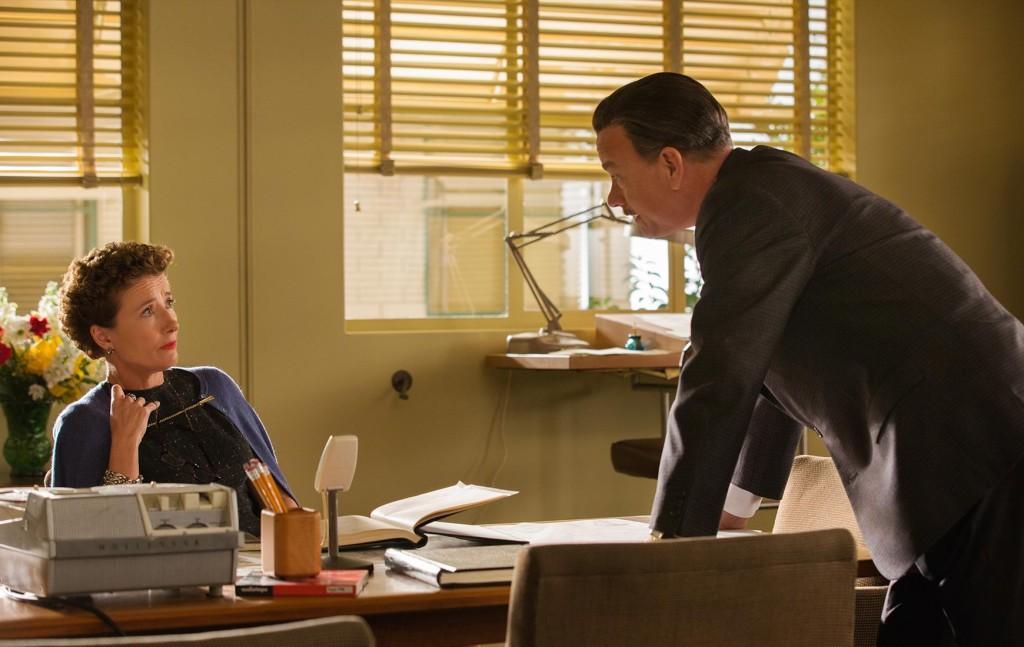“Saving Mr. Banks” brings magic
P.L. Travers (Emma Thompson) and Walt Disney (Tom Hanks) work on creating a a satisfying film adaptation for “Mary Poppins.” Photo courtesy of Disney.
December 22, 2013
Of the many distinct movies and TV shows that have filled my childhood, the 1964 film “Mary Poppins” stands at the forefront. At six years old, I remember sitting in front of my television, humming along to Julie Andrews and her timeless songs like, “A Spoonful of Sugar” and “Let’s Go Fly a Kite” and trying to pronounce the doozy of a word, supercalifragilisticexpialidocious, for the first time.
However, little did I know that the process of getting “Mary Poppins” on screen was actually extremely difficult.
Released in theaters on Dec. 13, “Saving Mr. Banks” dives into the story behind the fight of getting Mary Poppins to fly with her umbrella across the big screen, which took place during the 1960s. Tom Hanks portrays the good-natured Walt Disney, who promised his two daughters 20 years earlier to create an adaptation, while Emma Thompson embodies the prickly and uptight P.L. Travers, the author who breathed life into her magical flying nanny and refused for twenty years to give her rights and watch Disney butcher her beloved character.
After learning that her financial status is not as stable as it once was, Travers reluctantly relents and travels to Los Angeles to partake in the writing the script with the production team consisting of screenwriter Don DaGradi (Bradley Whitford) and musical brothers Richard Sherman (Jason Schwartzman) and Robert Sherman (B.J. Novak), becoming a difficult force in the process. She refuses to see her series become a musical or see animation, the color red and Dick Van Dyke take part in her in any aspect of the film.
Interspersing the humorous scenes of her clashing with the Disney production team is the darker story, which takes place in 1906, of a little girl named Helen (Annie Rose Buckley), who idolizes her charming father (Colin Farrel). However, we quickly discover that the hero in her eyes is quickly succumbing to alcoholism. As we find out that the story of Helen is actually the flashbacks of Travers, the twists and gloomy undertones of the growing cracks in her family provide a clearer insight into the cantankerous woman who hates pears and detests the power of money.
Despite the stellar cast, by far, Thompson really carried the film with her complex and nuanced acting. We initially watch Travers as a snippy woman who snaps at people, such as her sweet chauffeur, portrayed winningly by Paul Giamatti, and who continuously says “no” to the ideas the production team conjures.
However, as the story of Helen unravels, we find Travers vulnerable, haunted by her past and afraid of what her story could do to her characters, such as vilifying Mr. Banks or trivializing Mary Poppins, who was actually based off on someone who she believed could fix everything, and dismiss the story as something silly, something Disney-like with the frills of animation.
Hanks was also commendable for his accurate portrayal of Disney, all from his the dimensions of his mustache to the sparkling dialogue spoken in the Midwestern dialect. He brought back to the life the business man who insisted on being on a first-name basis with everyone, including Travers, fought back hard to uphold his promise as well as try to figure out what was holding Travers back from letting go of her characters.
Though I am a fan of movies produced by BBC films, I was originally skeptical when hearing that “Saving Mr. Banks” was also co-produced by Walt Disney Pictures. Going in, I expected a fluffy movie entirely glorifying Disney and his “struggles” to get what he wanted—however, going out, I was impressed with the directing of John Lee Hancock, rich storyline and nuanced acting by all the actors.
The cinematography of this movie was also gorgeous, especially the shots in Australia and the scene transitions, such as the one where Helen’s father shaves subtly changes to Travers clearing steam off of her mirror. It was also great watching the Sherman Brothers sing at a piano and collaborate with each other to create songs that we can recognize today.
However, as the film told two different narratives, the storyline with the present Travers was much more enjoyable from witty banters to the palpable—though not romantic—chemistry between the leads. It’s not because of the dark and uneasy undertones of the flashbacks but they dragged on too long, some that could even be cut shorter. Though flashbacks are important in the complex characterization of Travers, I didn’t even know that the film was about her father until much later in the movie, which was when it was little bit too late.
In addition, I wished the film capitalized more on Aunt Ellie (Rachel Griffiths), who became the basis of Mary Poppins. Her short scenes left me slightly confused—how much of an impact did she even make on Travers to make her refuse granting the rights to “Mary Poppins” for twenty years?
Despite the flaws I noticed, they didn’t detract too much from the experience. In fact, the film surprised me with heart-wrenching scenes that had the audience sniffling and left me a little more teary-eyed than I want to admit. The surprising tearjerker yet feel-good movie is definitely a spoonful of sugar for the holiday season.






